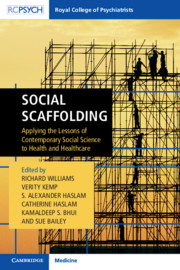Book contents
- Social Scaffolding
- Social Scaffolding
- Copyright page
- Contents
- Contributors
- Foreword
- Note
- Section 1 Schooling
- Section 2 Scoping
- Section 3 Sourcing
- Chapter 15 Crowds and Cooperation
- Chapter 16 Emergencies, Disasters and Risk Reduction: A Microcosm of Social Relationships in Communities
- Chapter 17 Shared Social Identity in Emergencies, Disasters and Conflicts
- Chapter 18 Complex Trauma and Complex Responses to Trauma in the Asylum Context
- Chapter 19 The Mental Health of Veterans: Ticking Time Bomb or Business as Usual?
- Chapter 20 Violent Radicalisation: Relational Roots and Preventive Implications
- Chapter 21 Ways Out of Intractable Conflict
- Chapter 22 Agency as a Source of Recovery and Creativity
- Section 4 Scaffolding
- Section 5 Sustaining
- Index
- References
Chapter 16 - Emergencies, Disasters and Risk Reduction: A Microcosm of Social Relationships in Communities
from Section 3 - Sourcing
Published online by Cambridge University Press: 14 June 2019
- Social Scaffolding
- Social Scaffolding
- Copyright page
- Contents
- Contributors
- Foreword
- Note
- Section 1 Schooling
- Section 2 Scoping
- Section 3 Sourcing
- Chapter 15 Crowds and Cooperation
- Chapter 16 Emergencies, Disasters and Risk Reduction: A Microcosm of Social Relationships in Communities
- Chapter 17 Shared Social Identity in Emergencies, Disasters and Conflicts
- Chapter 18 Complex Trauma and Complex Responses to Trauma in the Asylum Context
- Chapter 19 The Mental Health of Veterans: Ticking Time Bomb or Business as Usual?
- Chapter 20 Violent Radicalisation: Relational Roots and Preventive Implications
- Chapter 21 Ways Out of Intractable Conflict
- Chapter 22 Agency as a Source of Recovery and Creativity
- Section 4 Scaffolding
- Section 5 Sustaining
- Index
- References
Summary
Disasters and major incidents, while uncommon in each country, occur sufficiently frequently worldwide and have such societal impacts that they make headlines on most days. Perhaps, paradoxically, emergencies are so common as to be almost ordinary, if only in purely statistical terms, if it were not for the human impact, worry and suffering that is involved. This chapter shows how disasters are integral to and, thus, present a microcosm of our worlds. Our intention is to use them, in common with each of the topics in Section 3 of this book, to explore social influences on how people, communities and societies respond to and cope with the physical and psychosocial impacts of major events. This chapter links John Drury et al.’s exploration of the contribution of social psychology to crowd science in Chapter 15 with Drury and Alfadhli’s Chapter 17, on disasters. We intend that Chapters 15, 16 and 17 provide another window on the human condition, the importance of social relationships and the powerful influences of social identity.
- Type
- Chapter
- Information
- Social ScaffoldingApplying the Lessons of Contemporary Social Science to Health and Healthcare, pp. 137 - 153Publisher: Cambridge University PressPrint publication year: 2019



